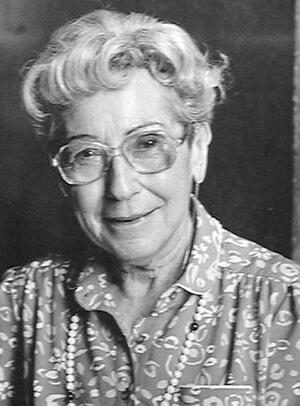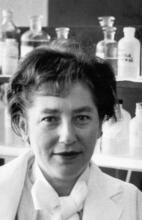Mildred Cohn
When Mildred Cohn (1913 – 2009) received her Ph.D. in chemistry from Columbia University in 1937, job postings at the university stated clearly: “Interviewing all Ph.D. candidates, male and Christian.” Eventually she became a professor at the University of Pennsylvania and the first woman on the editorial board of the Journal of Biological Chemistry.
Institution: Mildred Cohn.
After earning a master’s degree in chemistry from Columbia University, Mildred Cohn worked for the National Advisory Committee for Aeronautics, but she was given a position lower than the one she qualified for and was eventually banned from the lab because she was a woman. She returned to Columbia, earning her PhD in 1937 for studying organic reactions using isotopes. Cohn struggled to find employment, but in 1946 she began working at Washington University under Carl and Gerty Cori, who allowed her to pursue independent research. She built a mass spectrometer and studied cell metabolism and ATP, the chemical compound that transfers energy within cells. In 1958 she became an associate professor at Washington University, and in 1960 she joined the faculty of the University of Pennsylvania. Cohn was the first woman editor of the Journal of Biological Chemistry and served as president of the American Society of Biological Chemists. In 1964 she became the first woman to receive the American Heart Association’s Lifetime Career Award.
A pioneer in using new technologies to measure organic reactions, Mildred Cohn has received many top awards in the fields of chemistry and biology. Early in her career, she surmounted prejudice against women and Jews.
Early Life and Education
Cohn was born in New York City on July 12, 1913, to Isidore and Bertha (Klein) Cohn. Her father, trained as a rabbi in Russia, became a “militant atheist” involved in the Yiddish culture movement in New York. He worked in the garment and printing industries. Mildred had a brother, Albert, two years older.
Graduating at age fourteen from public school, Cohn majored in chemistry at Barnard College, while taking all available courses in physics. She received a bachelor’s degree in 1931 and, a year later, a master’s degree in chemistry from Columbia University.
Career Struggles and Successes
After passing a civil service exam for junior chemist, Cohn began to work at the National Advisory Committee for Aeronautics, a predecessor of NASA. She was given a position lower than the one she qualified for and was eventually banned from the laboratory because she was a woman, but she persevered in planning fuel-injection experiments that others carried out.
Cohn eventually returned to Columbia, where, under Harold Urey, she used isotopes to study reaction mechanisms. She received her Ph.D. in 1937, but still had difficulty finding work. According to Cohn, corporations seeking employees at Columbia posted notices, “Interviewing all Ph.D. candidates, male and Christian.” Luckily, Vincent du Vigneaud hired her as a physical chemist, originally at Washington University and later at Cornell University Medical Center. She again worked on isotopes, initially measuring the deuterium content of water. Nine years passed before she could choose her own research, and twenty-one years passed before she received a university appointment.
In 1938, Cohn married physicist Henry Primakoff. She did not change her name, preferring, during World War II, to reveal her Jewish identity. The couple had three children: two daughters, Nina and Laura, who became psychotherapists, and a son, Paul, who became a scientist. Her husband died in 1983.
In 1946, she moved to Washington University, where she worked with Carl and Gerty Cori, a husband-and-wife team who allowed Cohn to pursue independent research. Among other endeavors, she analyzed enzyme-catalyzed reactions and built a mass spectrometer. In 1958, she was appointed associate professor.
In 1960, Cohn became a faculty member at the University of Pennsylvania, and was made full professor within a year. In 1964, she became the only woman to receive the American Heart Association’s Lifetime Career Award, which provided generous support until she turned sixty-five. In 1978, the university appointed her the Benjamin Rush professor of physiological chemistry.
Honors and Legacy
Cohn was the first woman on the editorial board of the prestigious Journal of Biological Chemistry, where she was editor for ten years. Other honors include the American Chemical Society’s Garvan Medal, the Franklin Institute’s Cresson Medal, the International Organization of Women’s Biochemists Award, the National Medal of Science, and Columbia University’s Chandler Medal. She was president of the American Society of Biological Chemists.
Mildred Cohn started her career at a time of great innovation in physics. With her strong interest in physics, she reached new frontiers in understanding chemical reactions at the atomic level. She used innovative technologies—mass spectrometer, nuclear magnetic resonance, and electronic paramagnetic resonance—to elucidate organic reactions. Her research included metabolic studies, mechanisms of enzymatic reactions, ATP, and electron spin. Although she did not have a university appointment for two decades, she worked with scientists who were or would become Nobel laureates. Her low-profile jobs gave her not only flexibility to rear children, but also freedom for long-term projects that other scientists could not undertake, projects that eventually reaped rich rewards.
Mildred Cohn died on October 12, 2009. According to the Washington Post: "Dr. Cohn was named to the National Women's Hall of Fame one day before she died."
American Chemical Society. Videotape. American Men and Women of Science (1992).
Bailey, Martha J. American Women in Science (1994).
Cohen, Harry, and Itzhak J. Carmin, eds. Jews in the World of Science (1956).
Cohn, Mildred. “Atomic and Nuclear Probes of Enzyme Systems.” Annual Review of Biophysics and Biomolecular Structure 21 (1992): 1–24, and personal interview with author, June 26, 1996.
EJ.
Gortler, Leon. “Mildred Cohn (1913–).” In Women in Chemistry and Physics: A Biobibliographic Sourcebook, edited by Louise S. Grinstein, Rose K. Rose, and Miriam H. Rafailovich (1993), and oral interview at the Chemical Heritage Foundation, Philadelphia, Pa.
International Who’s Who (1993).
Who’s Who in America (1996).
Who’s Who in Science and Engineering (1994).
Who’s Who of American Women (1995–1995).
WWIAJ (1980).




